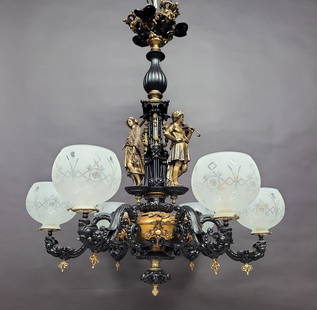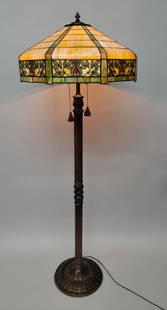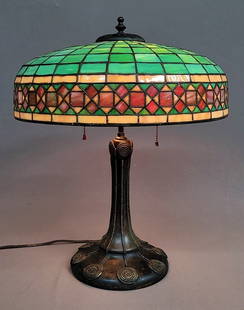
1856 San Francisco Committee of Vigilance
Similar Sale History
View More Items in Home & DécorRelated Home & Décor
More Items in Home & Décor
View More


Item Details
Description
19 1/2” x 14 1/4” framed and matted scroll /stone litho issued to Richard Lowry by the Committee of Vigilance of San Francisco, Reorganized 15th May, 1856 for the mutual protection of life & property. With original ink signatures by the President, Secretary, Treasurer and Grand Marshal. Stamped with the committee seal
The 1856 Committee of Vigilance
Next to 1848, when gold was discovered in California, 1856 was perhaps the most exciting year of the era by reason of the flood of crime into San Francisco that brought about the organization of the famous Committee of Vigilance, a form of direct action which attracted the attention of the world to a new style of summary justice. As for local conditions, it is enough to note that in the first ten months of 1855 there were 489 murders in California with only six legal executions. Stuffed ballot boxes were used to qualify the election of supervisors who often did not reside in their districts and ballot boxes with false bottoms were common place.
The years 1854 and 1855 were tumultuous at best. No one had time for city business because of the rush to the gold fields. Politics and the government of the City and State were neglected by the residents, and naturally the offices and emoluments fell to the criminal elements who came west. Some of the worst characters driven from New York's Bowery and from Botany Bay, Australia, held office and wallowed in corruption and graft. Trials in the courts were a farce, and those in power made no pretense of shielding their friends when charged with crimes. An honest man's vote was worthless at the polls, and ballot box stuffing was openly practiced.
James King of William (1822-1856), a prominent Bay Area banker born of an old Virginia family, was the man who single handedly started rousing honest residents to the struggle of cleaning out the criminal element in power. At that time, political corruption was closely affiliated with certain influential, wealthy people who shared in the profits of political connections. On October 8, 1855, King started a newspaper, the Evening Bulletin, whose purpose was to voice his convictions on the corrupt conditions in San Francisco. Critics said that no such paper, or anything similar, had appeared in any country. It was an ideal fighting journal, edited by a man who knew no fear, dealing devastating blows impartially.
So, when Charles Cora, a notorious gambler, shot down U S Marshal Richardson, and was formally arrested by his good friends in office, King, with his vigorous ardor, declared that if Cora was allowed to escape, the sheriff, David Scannell, should be hung.
The denunciations roused the ire of the public to a high pitch. King widened his range of attack against the political element, and took on James P Casey, one of the city supervisors, showing that he had been an inmate of Sing Sing Prison in New York. On May 14th Casey shot King as he was coming from the editorial rooms of the Bulletin. He was carried to a room in the Montgomery Block (now the site of the Transamerica Pyramid), but died a few days later at his home. Following the shooting, over ten thousand people crowded around the Montgomery Block to hear the latest on his condition. The crowd later retired to the Plaza, and soon a buzz went through the crowd that a Committee of Vigilance was forming. Meanwhile, Casey was being guarded in the jail on Broadway by hundreds of his friends and a company of militia. Friends of King were allowed to enter the jail to assure themselves that the prisoner had not been spirited away.
At nine o’clock the next morning, members of the 1851 Committee of Vigilance began to assemble in an old lodge room at Sacramento and Leidesdorff streets. Among them was William T. Coleman, a prominent member of the old committee. He was urged to start the new movement. Coleman wrote out the oath of fealty, urged that membership be impersonal and that each man should be known by a number. Life, liberty, property and honor were pledged.
.....By the time King died of his gunshot wound on May 20th, the Committee of Vigilance had swelled to 3,500 members under arms. With a cannon to batter down the doors, they then marched to the jail, but Casey was delivered to them after a short protest.
The committee later returned to the jail on Broadway and took Charles Cora to their headquarters. Both men were given advocates to defend them; both were tried before a jury composed of members of the Committee of Vigilance, were convicted and hanged from a platform extended from the second story windows of Fort Gunnybags.
An immense crowd filled Sacramento Street between Battery and Davis to watch the double hanging on May 22nd. Entrance to the committee's headquarters was protected with coarse sacks filled with sand and piled up nearly six feet thick and ten feet high. Cannons were placed at each corner. Inside was a platform and openings, from which a scathing fire of musketry could be unleashed.
There was a strong impression later that the rival Law and Order Party had obtained control of certain surrounding buildings from which they might fire on the makeshift "fort." To meet such an attack the Committee of Vigilance placed a cannon on the roof of Fort Gunnybags. These defenses could have been raided readily by a strong force, but the show of ample defense seemingly attained the object of the organization.
One prominent critic of the San Francisco vigilantes was General W T Sherman, who resigned from his position as major-general of the Second Division of Militia in San Francisco. In his memoirs, Sherman wrote: As [the vigilantes] controlled the press, they wrote their own history, and the world generally gives them the credit of having purged San Francisco of rowdies and roughs; but their success has given great stimulus to a dangerous principle, that would at any time justify the mob in seizing all the power of government; and who is to say that the Vigilance Committee may not be composed of the worst, instead of the best, elements of a community? Indeed, in San Francisco, as soon as it was demonstrated that the real power had passed from the City Hall to the committee room, the same set of bailiffs, constables, and rowdies that had infested the City Hall were found in the employment of the Vigilantes.
Buyer's Premium
- 20%
1856 San Francisco Committee of Vigilance
Estimate $3,500 - $5,000
1 bidder is watching this item.
Shipping & Pickup Options
Item located in Mesa, AZ, usSee Policy for Shipping
Payment

Related Searches
TOP



















(PR)Dimensions: 13" Dia.](https://p1.liveauctioneers.com/3975/123330/62761041_1_x.jpg?height=310&quality=70&version=1528391603)











































